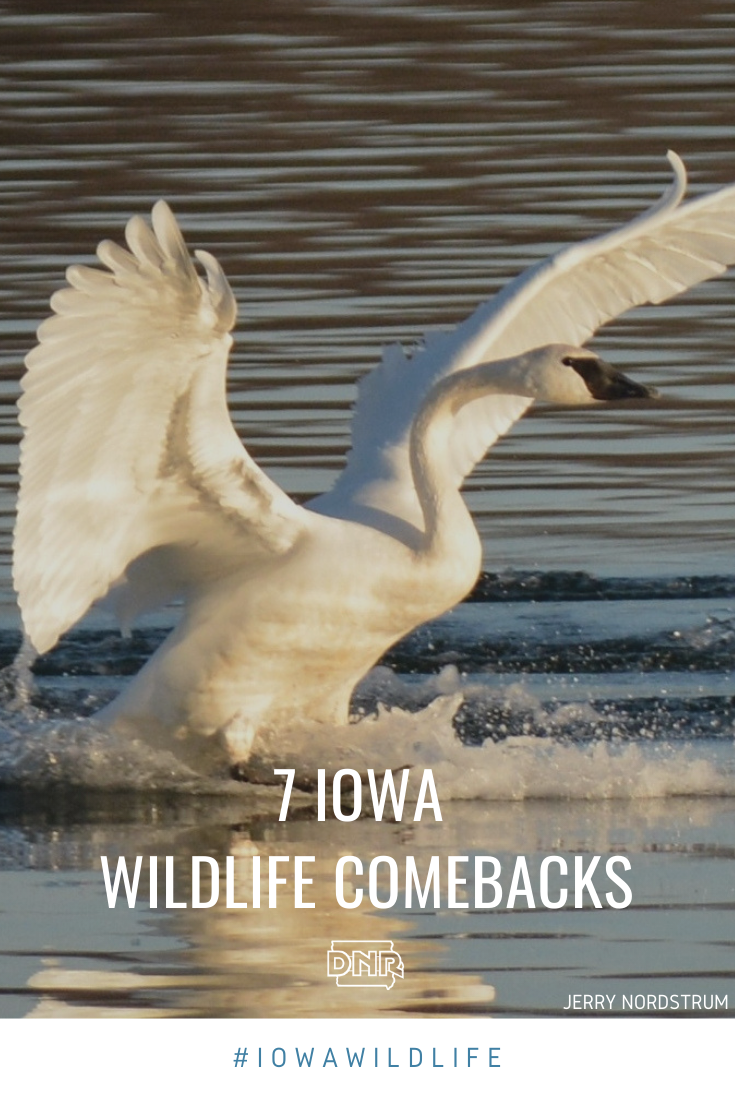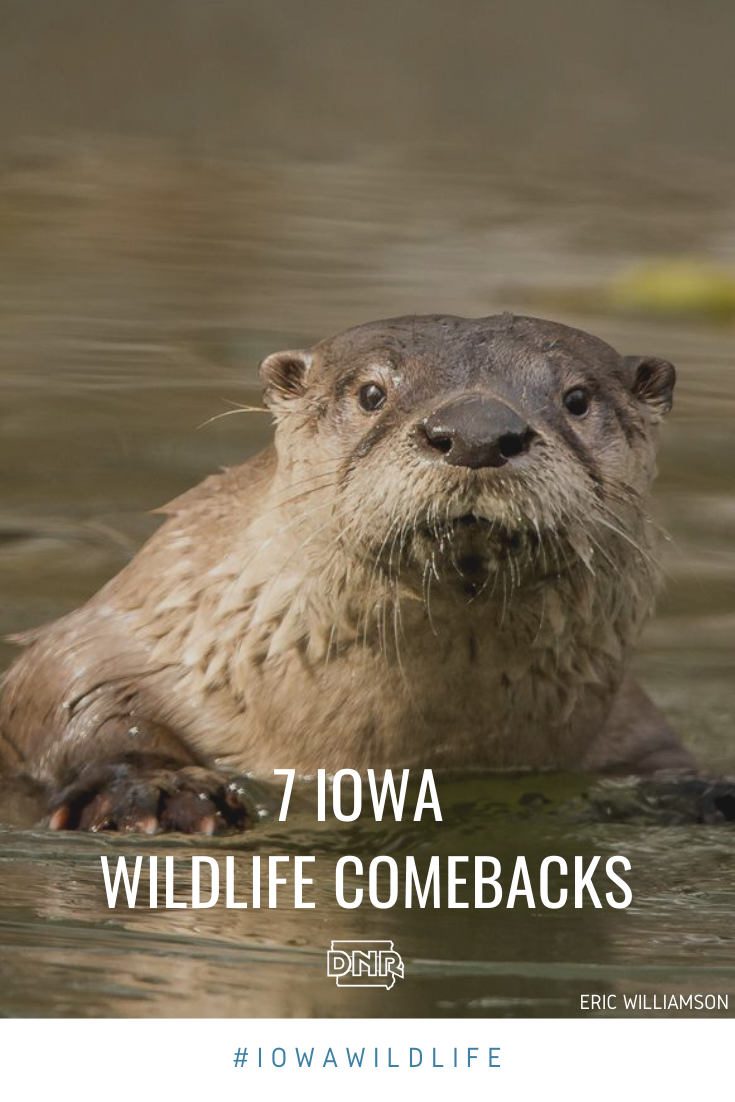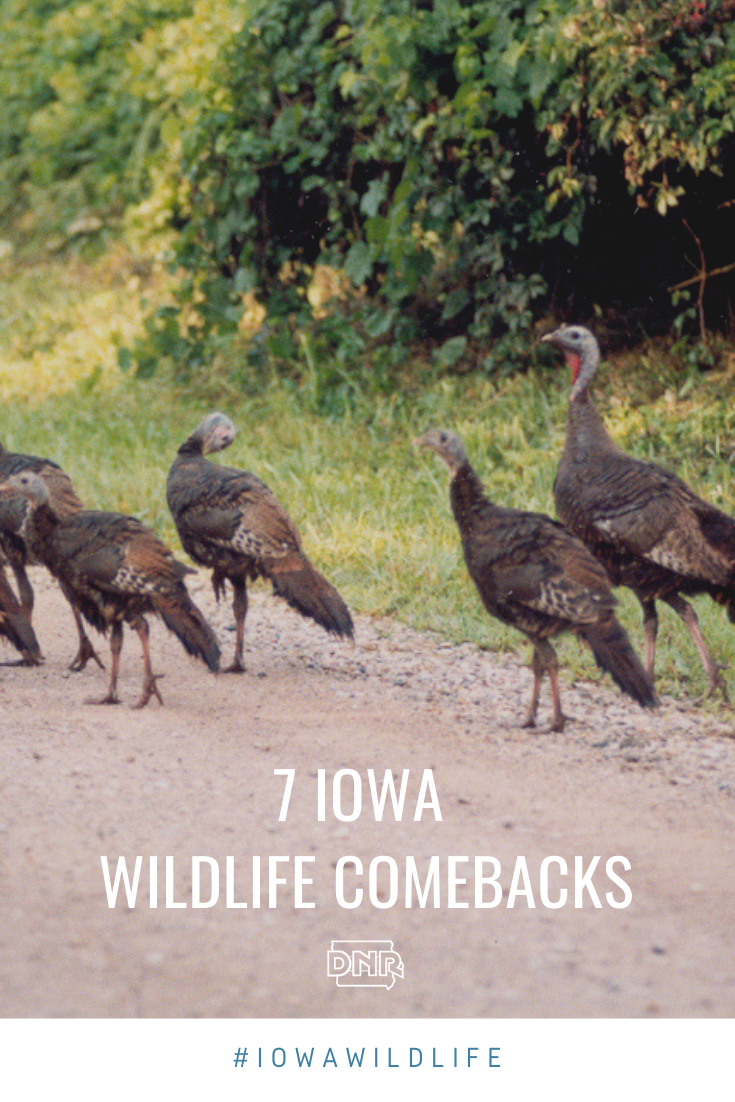In the last few centuries, a number of Iowa wildlife species have been extirpated from the state - but some have seen successful comebacks, too.
Check out these seven animals that have made a comeback in Iowa:
 Trumpeter swan
Trumpeter swan
Before European settlement of Iowa, trumpeter swans nested throughout the state. Soon after, the draining of many wetlands for agriculture, along with unregulated hunting, led to the loss of trumpeter swans in the state by 1883. A nationwide count in the early 1930s found only 69 swans in the continental United States, all in the Red Rocks Lakes National Wildlife Refuge in southwest Montana.
The swans gained nationwide protection in 1918. The U.S., Canada and Mexico signed the International Migratory Bird Treaty, making it illegal for the birds to be taken, possessed, sold or harmed. Seventy-five years later, in 1993, the Iowa DNR developed a plan to restore trumpeter swans to the state. The first nesting pair in the state since 1883 hatched three cygnets (baby swans) in 1998.
The DNR released cygnets in 1994 and have continued to do so every year, obtaining the swans from breeding pairs from volunteer private propagators, county conservation boards and zoos across the country, with a total of 141 contributing sources to date. The southern half of the state is currently the priority area for restoration work, as it’s part of the swan’s historical range. Only three nesting pairs can be found south of I-80 currently. Across the state, at least 54 nest attempts occurred in 2019.
Swans serve as ambassadors for wetland habitat restoration and water quality issues. You can check out various conservation programs on ways you can improve water quality and attract wildlife, like swans, to your area.
Peregrine falcons
Before the 1960s, peregrine falcons thrived in the eastern U.S. with a count of more than 350 nests. By 1975, only 39 peregrine pairs remained in the lower 48 states. DDT pesticides caused the species’ decline as they ran through the food chain. Insect-eating birds ate DDT-covered insects. Peregrine falcons then ate the birds affected by the pesticides. The DDT inhibited the falcon’s ability to produce enough calcium for eggshells, which led to reproductive failure. The pesticides were federally banned in 1972, but peregrines needed to recuperate their population.
The restoration project began with the release of 10 birds in Cedar Rapids in 1989, followed by 13 more in 1990. Another 19 were released in the Des Moines area in 1991. Between 1989 and 2003, the Iowa branch of the project released 169 peregrine falcons, part of 875 birds across the Midwest.
In 1999, for the first time in nearly 40 years, five pairs of peregrines nested along the cliffs of the Mississippi River, part of their historic nesting grounds.
Today, most nesting occurs in the eastern half of the state. A network of volunteer and professional surveyors monitor the nesting sites. In 2018, 14 active nests produced at least 20 fledglings. Four pairs nested in hard-to-monitor places and had unknown outcomes. The nesting population appears to be stable, and the DNR will continue to monitor the birds.
 River otters
River otters
Native to Iowa, river otters were mostly wiped out of the state in the early 1900s, except for a small population on the Mississippi River. Habitat loss, unregulated trapping and hunting, and reduced water quality all contributed to the downslide of otters in Iowa.
In 1985, a reintroduction program began at Red Rock Reservoir. Otters were brought from Louisiana to Iowa, and by 2006, they had spread statewide.
Now spotted in every county, otters have taken to the state. A regulated trapping season started in 2006. Furharvesters are allowed to harvest two otters per season to help regulate the population without overharvesting.
Bobcats
An animal once widely spread across the U.S., bobcats almost completely disappeared from the Corn Belt. Unregulated hunting by early settlers, combined with habitat loss in a changing landscape, caused the cat population to decline.
In 1977, bobcats became protected and listed as endangered on Iowa’s threatened and endangered species list. They started reentering the state, coming from Kansas, Nebraska and Missouri, into the southern part of the state. With no legal harvest allowed, the bobcats started to breed in Iowa, slowly growing and expanding the population. By the late '90s and early 2000s, more sightings began to occur in southern Iowa.
In 2007, the first regulated bobcat harvest season occurred. Regulations on harvesting the cat ensure the population is sustained as they continue to naturally repopulate the state.
Wild turkeys
Nationwide, wild turkey numbers were originally in the millions. These birds, abundant while Lewis and Clark explored the area during the Louisiana Purchase, were considered extirpated from Iowa, and most other states, by 1910. The last known Iowa turkey was seen in Lucas County.
The turkey population was unable to withstand year-round hunting. The clearing of forested areas also negatively impacted the turkey population. By 1920, there were only approximately 250,000 eastern wild turkeys left in the entire United States and they occupied only 12 percent of their former range.
Rehabilitation efforts began in the 1920s with releasing pen-raised turkeys. These efforts were unsuccessful because the turkeys had lost the instincts needed to survive in the wild. After many failed attempts over several decades to transplant pen-raised turkeys to the wild, no free-ranging turkey populations were produced. In the 1950s, turkeys were able to be moved to unoccupied habitats thanks to the development of the rocket net trap. Thirty years later, numbers had increased nationwide to 1.8 million birds in 47 states.
Officials were hopeful that turkeys would only thrive in the major forest areas of Iowa. The birds quickly adapted to the diverse landscape of the state. They adapted so well that the first modern day turkey season in Iowa was held in 1974. Now, wild turkeys live in all states except Alaska with an estimated population of 7 million.
 White-tailed deer
White-tailed deer
In the early 1800s, white-tailed deer were abundant throughout the state. Iowa’s changing landscape might have improved the conditions for the deer, but uncontrolled hunting for food and hides rapidly reduced the population. Deer were rarely sighted in Iowa by 1880 and in 1898, the hunting season was legally closed. By then, the animal was virtually eliminated from the state.
With protection from hunting, deer made their way back to the state. The reestablishment of the species can be traced to escapes and releases from captive deer herds, as well as translocation and natural immigration from deer herds in surrounding states. By 1936, there was an estimated 500 to 700 animals in Iowa. This number grew steadily and by 1950, the population topped 10,000.
By 1953, the first modern season was held and 4,000 deer were harvested. Currently, the population is estimated to be around 400,000 with around 100,000 animals harvested during the hunting season. Careful management of deer plays a crucial role in allowing deer population to stay in check.
Wild brook trout
Brook trout in Iowa have been affected by changes in the water. Management of the species dates back as early as 1875 with the first documented stocking of 800 brook trout near Anamosa.
In the early 1900s, there were attempts to improve trout habitat in Glover’s Creek, Coldwater Creek and Maquoketa River and the first plan for Iowa’s trout program was printed in 1983. The plan highlighted trout stocking as the main form of management.
Today, trout are widely distributed across the state. Wild self-sustaining populations of trout are now present in more than 50 streams across eight counties of northeast Iowa.